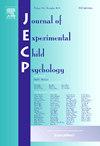From social inhibition in childhood to social facilitation in adulthood: How social presence systematically enhances the predominant response strategy in cognitive tasks
IF 1.8
2区 心理学
Q3 PSYCHOLOGY, DEVELOPMENTAL
引用次数: 0
Abstract
This study investigated the developmental trajectory of social facilitation and inhibition across 207 participants aged 8–22 in numerosity and phonological comparison tasks. Tested alone or in coaction with a familiar age-matched partner, younger participants exhibited social inhibition on reaction times (RT), while a shift toward facilitation occurred around ages 13–14. Analysis of individual RT distributions revealed that social presence modulated predominant response strategies: younger participants used slower, reactive strategies, while older participants employed faster, anticipative ones. By enhancing the strategy predominating in each age group, social presence led to social inhibition in children and early adolescents, but social facilitation in mid-adolescents and adults. There was no influence of the partner’s presence on accuracy, suggesting that while social presence modulated this predominant response, the presence of a partner did not impact the task performance in terms of correct answers. Together, these findings challenge Zajonc’s “dominant response” theory, suggesting that social presence affects overall decision-making strategies.
从童年的社会抑制到成年的社会促进:社会存在如何系统地增强认知任务中的主要反应策略
本研究考察了207名8-22岁被试在数字和语音比较任务中的社会促进和抑制的发展轨迹。单独测试或与熟悉的年龄匹配的伙伴合作测试,年轻的参与者在反应时间(RT)上表现出社会抑制,而在13-14岁左右发生向促进的转变。对个体RT分布的分析显示,社会存在调节了主要的反应策略:年轻的参与者使用较慢的反应性策略,而年长的参与者使用更快的预期性策略。社会存在在儿童和青少年早期导致社会抑制,在青少年中期和成人导致社会促进。搭档的存在对准确性没有影响,这表明虽然社交存在调节了这种主要反应,但搭档的存在并不影响正确答案的任务表现。总之,这些发现挑战了扎戎的“主导反应”理论,即社会存在影响整体决策策略。
本文章由计算机程序翻译,如有差异,请以英文原文为准。
求助全文
约1分钟内获得全文
求助全文
来源期刊

Journal of Experimental Child Psychology
Multiple-
CiteScore
4.50
自引率
7.70%
发文量
190
期刊介绍:
The Journal of Experimental Child Psychology is an excellent source of information concerning all aspects of the development of children. It includes empirical psychological research on cognitive, social/emotional, and physical development. In addition, the journal periodically publishes Special Topic issues.
 求助内容:
求助内容: 应助结果提醒方式:
应助结果提醒方式:


